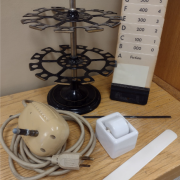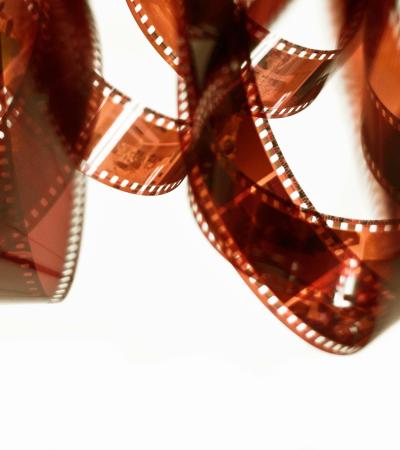This exhibit featured library and office equipment from the pre-web era, including a rubber stamp carousel, a card sorter and a vintage electric eraser. Visitors were invited to take a short multiple-choice quiz to guess the use of each item. Quiz takers who earned a perfect score were then entered to win a drawing for a book lover’s goodie bag.
Advanced Planning
My goal for this program was to stage a library-centric exhibit that was fun, engaging and educational. About a month ahead of time, I consulted with our technical services staff, who generously agreed to lend me several library artifacts they had preserved from previous eras.
After selecting a suitable exhibit location on a recessed counter in our front lobby, I created numbered, free-standing labels out of cardstock to place beside each item. I then wrote a multiple-choice quiz, referring to each item by its number label (for example, “Item #1 was used to store and organize: a. library cards b. rubber stamps,” etc).
After displaying the items for a week, we removed the quiz and put up new signage that revealed the correct answers, which remained on display for an additional week. I also took pictures of the items with the correct answers to post on social media and announced our prizewinner.
Marketing
We began promoting the exhibit a few days in advance. In addition to our regular promotion (flier distribution, electronic signage, posts to social media and our events calendar), I also staged the display in the front lobby where visitors would be more likely to notice it. I considered our marketing efforts successful because not only did visitors come to the library specifically requesting to view the exhibit, but most people who passed through the lobby stopped to look at it as well.
Budgeting
Because the exhibit consisted solely of items that already belonged to the library, costs were minimal. In addition to the expenses associated with printing and cardstock, I spent about $20 on our raffle prize. However, this cost could easily be reduced or eliminated by awarding a less expensive prize such as a library fee waiver or perhaps a gift donated by a local business or organization. Since the prize is not essential to the exhibit, you could forgo it altogether – although I think this element makes the program more fun and engaging.
Day-of-event Activity
On the day of the event, I was able to stage the exhibit by myself within a few minutes. Since I was off work on the day the display signage was scheduled to be swapped out, I enlisted the help of a second staff person to oversee this step. Front desk personnel also pitched in during the event by answering visitors’ questions and collecting quizzes.
The main challenge I encountered was that several visitors were tempted to touch and handle the items – a consequence of the fact that I didn’t have a closed display case available at the time of the exhibit. Fortunately, since none of the items were particularly fragile, none were harmed. However, a display case would have been essential if more delicate or valuable pieces had been included.
Program Execution
In total, we had twenty-five participants who took the quiz, and many more who stopped to view the exhibit. An especially pleasant surprise occurred when a group of faculty members made a trip to the library together just to view the exhibit, razzing each other as they took the quiz in a spirit of friendly competition! I was encouraged to see many visitors return during the second week to view the quiz answers, which I took as evidence that they were learning from the exhibit in addition to enjoying themselves. The feedback we received was overwhelmingly positive, with visitors reporting to staff that they found the exhibit fun, interesting and unique.
This program confirmed for us that passive library programs can be just as impactful for our patrons as active ones – and in some ways, even more so. Because passive programs typically take place over a longer period of time, they allow patrons more time and flexibility to participate, often resulting in higher engagement numbers. We also noted that the exhibit attracted visitors of all ages, highlighting that programs with a historical focus can be a powerful way to engage a wide cross section of the community. The UAH community’s interest in this program was borne out not just by the positive feedback we received through informal discussion with our patrons, but also by the high volume of foot traffic the exhibit received.
Advice
If you’re interested in staging a similar exhibit, start by exploring your library’s storage spaces with an open mind. Objects that might initially seem mundane – like an old due date stamp or a catalog card – can, with the right presentation, make for an engaging display. Reach out to coworkers, too; you never know who might have a treasured keepsake they’d be willing to lend.
In addition to artful staging, a well written multiple-choice quiz is essential; half the fun is guessing the purpose of each item. A good rule of thumb is to provide two wrong but plausible answers, plus one silly one – patrons will get a kick out of it!
A quick word of caution, here, however: Take care to avoid a tone that could be misinterpreted as derisive, aiming instead to promote curiosity and appreciation for older technology. (This goes double for any items on loan from others!)
If you keep these considerations in mind, you may be surprised by how well your exhibit is received – and how much conversation it inspires. Younger library users will enjoy exploring this unique window to the past and older patrons will appreciate the retrospective just as much – if not more so!




